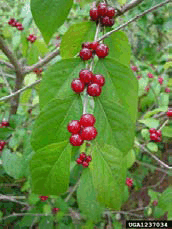Green Horizons
Volume 18, Number 2Spring 2014
Bush Honeysuckle: What it is and how to control it
By Hank Stelzer
Bush honeysuckle refers to several species of this invasive plant. The most common in Missouri is the Amur honeysuckle (Lonicera maackii). Originally from parts of Asia, it was introduced in the U.S. in the late 1800s for use as an ornamental. In the 1960s and ‘70s, it was promoted for conservation and wildlife uses, and it expanded through the eastern U.S.
These non-native plants thrive in full sunlight, but can tolerate moderate shade, and are therefore aggressive invaders of a variety of sites including abandoned fields, roadsides and the interiors of open woodlands. It shades out desirable native woodland species, and can form pure, dense thickets totally void of other vegetation. Reproduction and spread is by both sprouting and seeds, which are disseminated primarily by birds.
While honeysuckle fruit is rich in carbohydrates, it lacks the high-fat and nutrient-rich content that most native plants provide migrating birds. Wherever invasive honeysuckle shrubs displace native forest species, there is a huge potential impact on migrating bird populations due to the reduction in availability of native food sources.
Identification
Amur honeysuckle leafs out earlier in the spring and retains its leaves later than most native plants. To identify non-native bush honeysuckle, look for shrubs with long arching branches and the following characteristics:
- Leaves-1 to 3.5 inches long without teeth, arranged oppositely along the stem; dark green with a pointed tip.
- Stems-grayish-brown, with short hairs on young stems; older, larger stems have broad ridges and grooves and appear striped; older stems are hollow (native honeysuckle is solid).
- Flowers-white, fragrant tubular flowers, less than one inch long, along the stem in pairs from early to late spring.
- Fruits-quarter-inch round berries in clusters of 2 to 15; commonly red. Produced mid-summer to early fall.
 |
||
CHUCK BARGERON / UNIVERSITY OF GA. |
||
Bush honeysuckle is an aggressive invasive plant that can overtake your woodland in a few short years, crowding out native forbs and shrubs that provide nutritious food for a wide variety of wildlife species. |
||
Control Methods
Since bush honeysuckle can sprout prolifically from the stump, any control method must remove the stump. Most removals require hand application of herbicides.
Mechanical Control
Removing the stump is an option. Any lateral roots left are unlikely to sprout a new plant. Small, kneehigh plants can be removed by hand, especially after a rain since they possess shallow root systems. Larger plants can be removed with devices like weed wrenches and poppers that are designed to remove shrubs. Mechanical control requires a significant amount of labor.
Chemical Control
Effective herbicide control methods include foliar sprays for small plants and cut stump applications for larger ones. With foliar spraying, a diluted herbicide goes directly on the leaves of targeted plants. This can be a very effective method, but should only be used when the target plants are within easy reach of the sprayer. In addition, care needs to be taken to ensure that herbicides are sprayed to wet the foliage but not to the point of runoff.
Bush honeysuckle leaves remain green late into fall (early- to mid- November) when most native plants have gone dormant. Foliar applications of some herbicides can be used at this time with little to no impact to nontarget species especially after the first hard frost in the fall.
Cut stump treatments are very effective at controlling undesirable woody shrubs and work well on bush honeysuckle. It involves cutting the shrub close to the ground to apply a herbicide to the cut surface.
Utilize an oil-soluble herbicide (not water-soluble) when planning to return later to treat the stumps. Apply it to the entire top and sides of the cut stump without causing excess runoff. Apply as long as the stumps are dry and not frozen, like in the late summer, early fall or dormant seasons. Avoid applications during sap-flow (spring) as this lessens the effectiveness.
Monitor plants for at least one year to determine if complete control is achieved. Any plants that are not completely killed by the first treatment will warrant a follow-up treatment.